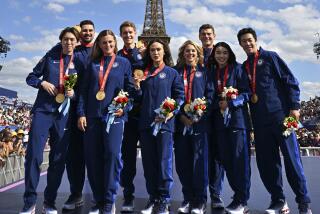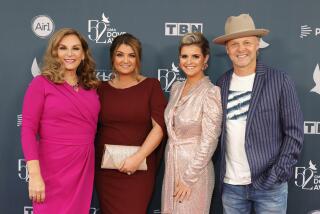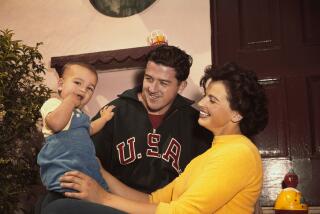Plane crash anniversary elicits emotions in U.S figure skating community
Linda Leaver could not handle the news she got in a phone call from a friend on Feb. 15, 1961.
So she locked herself in her room for four days. And for the next 50 years, she locked away her feelings about what happened, never discussing it even with Brian Boitano, whom she coached to the 1988 Olympic gold medal.
“I didn’t know how to deal with it,” Leaver said. “I kept it deep inside me.”
Leaver was 17, a high school senior in Tacoma, Wash., when she learned a plane crash had killed the entire 18-member U.S. figure skating team on its way to the world championships in Prague in what was then Czechoslovakia.
Sixteen people accompanying the skaters — coaches, officials, family members — and 38 passengers and crew members also died when the Sabena flight from New York plunged into a field while trying to land at its scheduled stop of Brussels. There were no survivors.
It was, at the time, the worst air disaster involving a U.S. sports team. The press coverage was enormous. President Kennedy expressed his condolences.
Bill Hickox, 18, of Berkeley, the pairs skater who often was Leaver’s escort at post-competition parties, was on the flight. So were the Hadleys, sibling pairs team Ila Ray, 18, and Ray Jr., 17, with whom Leaver shared training ice at Seattle’s Civic Arena three days a week, as well as the Hadleys’ stepmother, Linda, 31.
During the U.S. championships in Greensboro, N.C., late last month, U.S. Figure Skating marked the 50th anniversary of the tragedy by inducting all 34 members of the world team traveling party into its Hall of Fame.
A reception also was held that included family and friends of those who died as well as members of the tight-knit figure skating community. At one point , Leaver felt so overwhelmed she had to leave.
“For a long time, all those memories had not come back to the forefront,” she said. “I was finally confronted with everything right then. I sensed it was the same way for a lot of people.”
She wasn’t alone.
“The sound of the words ‘February 15th’ makes you cringe,” said Joan Sherbloom Peterson of Orange, whose sister, Diane, was among the dead.
A nation whose skaters had become the best in the world suddenly was faced with the sad task of rebuilding. Yet within months, a memorial fund was established that would turn part of the 1961 team’s legacy into financial help for those who followed, including Peggy Fleming, who would win Olympic gold in 1968.
“It was like a phoenix rising from the ashes,” Boitano said.
The celebration of that renaissance, as well as a remembrance of the lives lost, is central to the film “RISE,” a U.S. Figure Skating project that will have a nationwide theatrical showing Thursday, including at a number of Regal, AMC and Cinemark theaters in the Los Angeles area, with all ticket proceeds going to the memorial fund.
A new book, “Indelible Tracings,” also tells the story. Patricia Shelley Bushman’s painstakingly detailed research brings back the vibrant personalities of those on the plane.
It also brings back the emotions.
“I think the anguish was enough to inhibit communicating about this for 50 years,” said U.S. Figure Skating historian Ben Wright, 89, friend to many of those who died. “The anniversary has broken the ice.”
To understand the far-reaching resonance of the tragedy requires context.
Figure skating essentially was a European sport before World War II. No U.S. skaters won an Olympic or world title until Dick Button got both in 1948.
At the same time, actress Sonja Henie — who won three Olympic gold medals for Norway by 1936 — had popularized the sport in the U.S. Her friends built rinks in the L.A. area, while the ice resurfacing machine that Californian Frank Zamboni invented in 1949 got wide publicity when Henie took a version of it on the road.
By early 1961, the U.S. had won four Olympic golds in men’s singles, two in women’s singles, two medals in pairs, plus 20 world titles. Interest especially leaped after Carol Heiss and eventual brother-in-law David Jenkins were among the gold medalists in the 1960 Winter Games in Squaw Valley — the first Olympics televised in the U.S.
On the 1961 world team, there were five skaters from Boston, figure skating’s traditional and exclusionary breeding ground, and eight from the West Coast.
That included Diane Sherbloom, 18, of L.A., an ice dancer whose presence on the team was a quirk of fate.
Marilyn Meeker, who finished second in dance at the 1960 nationals with partner Larry Pierce, broke her ankle in a training accident in December 1960. Pierce called Sherbloom, with whom he had skated a few times for fun. Six weeks later, Sherbloom and Pierce were U.S. champions.
Sherbloom left for the nationals in Indianapolis on Dec. 18 — the last time Joan, then 15, saw her sister.
“Memories are a picture book in your mind,” Joan said during the commemoration in North Carolina. “When someone passes on, you have to close the book to go on. This has opened that book up again.”
It has made Joan recall, with undisguised bitterness, that neither the airline nor skating officials had called with the news of her sister’s death before she learned about it from reporters who came to the family’s house.
She remains angry over her mother’s having been told at first she would have to pay for the shipment of Diane’s belongings, remains angry that the body came back with her sister’s identification written on a price tag.
Asked if the memorial fund gave her a feeling that some good had come from the deaths, Joan responded with an emphatic, “No.” Her husband, Ray, said the North Carolina ceremony was “long overdue.”
The fund, which has given out $10 million over the years, has helped many skaters, though. Christopher Ryan Nolan is one of them. He is a grandson of crash victim Danny Ryan, coach of Sherbloom and Pierce.
“It is wonderful that it came back full circle,” said Sheryl Ryan Nolan, 51, one of Danny’s five children and a skating coach in Atlanta.
Danny Ryan’s wife, Rose Anne, who died last November, also was a skating coach. Their youngest son, Michael, was 2 weeks old when the plane crashed.
“People asked my mother, ‘What will you do?’ now,” said Terri Ryan Sullivan, 52, of Clinton, N.Y., the elder daughter, also a skating coach. “She answered, ‘I will go to the rink and teach lessons and feed my kids.’ Mom met life head on.”
The 50th anniversary has given the Ryan children images of their father they had never seen, including video the filmmakers found.
“I can’t believe I was seeing my father move,” Terri said. “He had been just a memory.”
The most vivid images were left by Maribel Vinson Owen, then the most renowned female skater in U.S. history, an irrepressible force of nature who won nine national singles titles — a U.S. record matched 68 years later by Michelle Kwan — and six national pairs titles. She also was a journalist, coach and chauffeur for her skaters.
Vinson Owen, 49, was on the plane with her daughters, whom she coached: Laurence, 16, who had just become national singles champion, and “Little Maribel,” 20, who was to skate pairs with Dudley Richards, 28, who had been Sen. Ted Kennedy’s Harvard roommate.
Laurence Owen was on the cover of that week’s Sports Illustrated.
“As a coach, she was a cross between Bela Karolyi and Bill Belichick. Some skaters feared her. But we all knew she cared,” said Paul George, one of her students.
George thinks Vinson Owen’s indomitable spirit infused the resolve with which U.S. skaters and skating officials began the rebuilding process that led to sooner-than-expected success — Scott Allen’s Olympic singles bronze and Vivian and Ron Joseph’s pairs bronze in 1964, Fleming’s gold in 1968 — and decades of excellence.
“After we got over our stunned sadness, we were more serious,” George said.
For Barbara Roles, the deaths have been a driving force for 50 years.
At 18, Roles had won the singles bronze medal at the 1960 Olympics and retired, a decision she was reconsidering until she learned she was pregnant — and so was not on that plane. Not long after her daughter was born in June 1961, Roles was asked by U.S. skating officials if she would come out of retirement to help bridge the gap to the future.
“I almost had a guilty feeling that I was spared,” Roles said.
“I haven’t spoken about all this much until this year. The anniversary has helped me express my feelings.”
She returned to win the national title in 1962. And she knew everyone on the 1961 world team.
“Over the years I never said I was urged on by the crash,” said Roles, who has coached for the last 47 years to share the “joy of skating” those who perished had felt. “But I was.”
More to Read
Go beyond the scoreboard
Get the latest on L.A.'s teams in the daily Sports Report newsletter.
You may occasionally receive promotional content from the Los Angeles Times.










